THE SANGUINE ROOT VISITS A SITE OF PROFOUND BEAUTY IN PENNSYLVANIA. THE MIDDLE OF THE MONTH OF APRIL IS THE TIME TO SEE A HILLSIDE OF VIRGINIA BLUEBELLS AND TRILLIUM ERECTUM VARIATION ALBUM AND TRILLIUM FLEXIPES ALL BLOOMING AT THE SAME TIME.
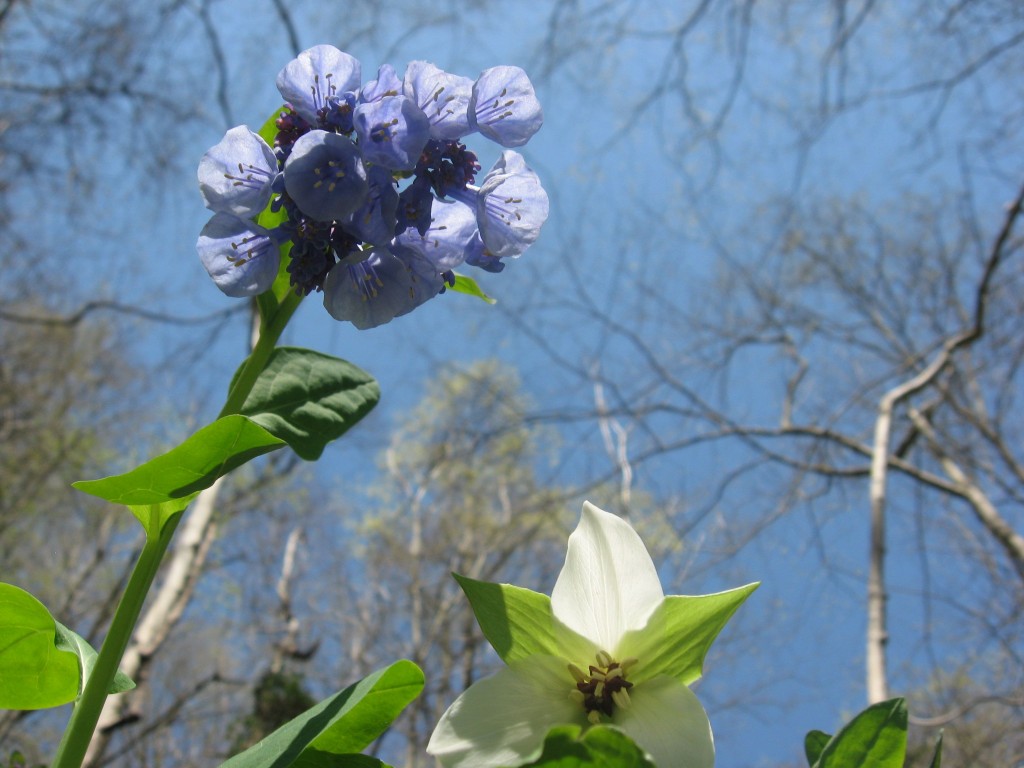
We had heard about this place where Bluebells and Dutchman’s breeches cover hillsides. Â Trilliums abound in the millions. The ‘Rich ravines of the lower Susquehanna River’. Â We heard how it is hard to find and off the beaten path, with bumpy dirt roads and an ancient stone tunnel that you must pass through to reach the other side. Â Once you make it through this tunnel, the landscape is transformed, and you are in a primordial world, with ancient trees and wildflowers abundantly growing.
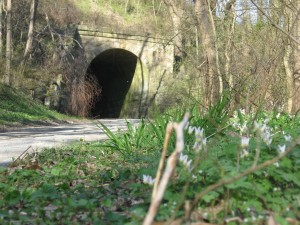
This is the stuff of myths. Â How can it be possible that a native wildflower wonderland can appear by passing through an an old stone tunnel on a dirt road? Â We decided to make a go of it last year, in the spring of 2010, and after a long morning of directions, turns, and crinkled maps, somehow we found a sign along the River Road in some place very remote but only about 2 1/2 hours from Philadelphia, that pointed to Shenks Ferry Wildflower Preserve. We bumped along, following the well-marked signs, and our 1999 Suburu Legacy outback stationwagon had no problem with the dirt road. Â We kept going along and bumping up and down and there was the mythological stone tunnel before us. Â We crept through the dark tunnel on the dirt road and finally reached the other side.

It was just what the hype had described. Â On the incoming side of the tunnel was a rural and bucolic landscape of well- manicured homes with non-native trees, grasses and flowers and large expanses of mowed lawns.
On the other side was the mythological rich ravines of the Lower Susquehanna River. We could hardly drive to the trailhead without being distracted by the large swaths of blue and white covering the rich hillside. Â The blue, being Bluebells, (Mertensia Virgininica) and white, being Trillium Erectum v. album, Â Trillium flexipes or most likely a hybrid of both, most specimens indistinguishable in this interbreeded population.
We had reached a place where our piedmont landscape was deeply dissected with a magnificent river, the Susquehanna, and there were small creeks that also deeply dissected the landscape as they made their way to the wide and low Susquehanna. Â These ravines are cut so deep into the piedmont that they have steep slopes that provide a protected micro-climate, allowing a huge diversity of plants to grow, especially spring ephemeral wildflowers. Â This is Shenks Ferry Wildflower Preserve. Â Owned By Pennsylvania Power and Light Company, whose electric lines cross through the area, it is open to the public and has a trailhead with brochures, and a bulletin board. Park on the side of the road, and when you get out of the car, take care to not step on the wildflowers abundantly growing in the parking area.
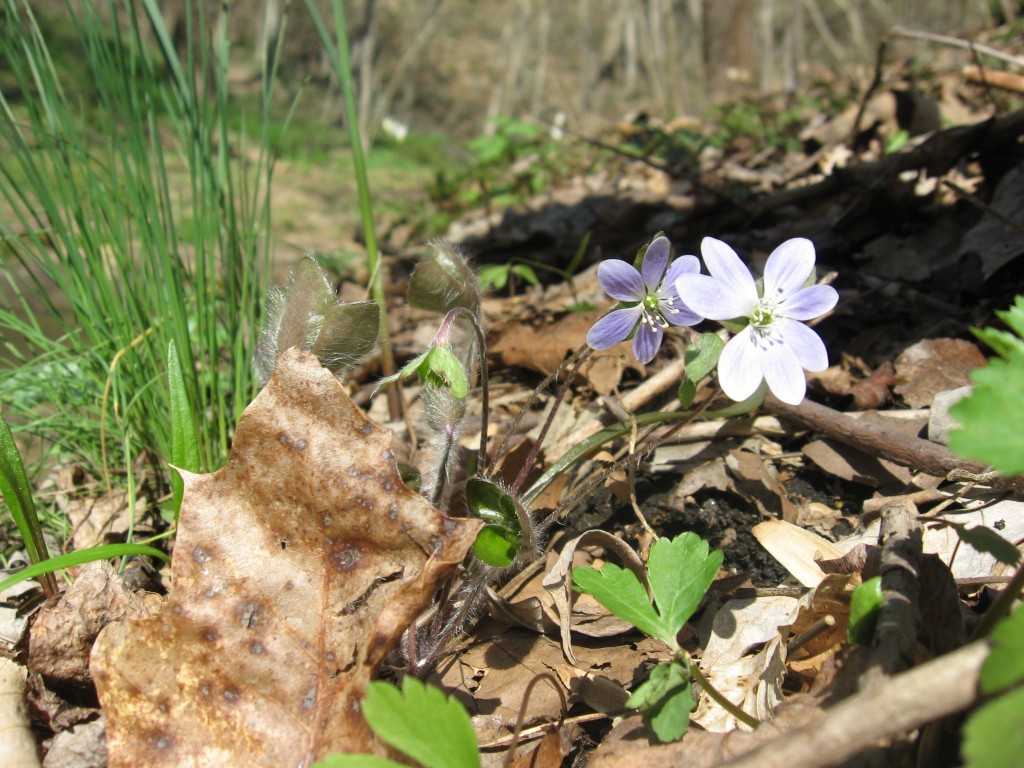
Last week, we selected Thursday April 14, 2011 for our trip to Shenks Ferry, and it was a success. Â The Trilliums were in bloom and so were the Bluebells. It was not peak bloom, but close enough, especially with the amazing weather we had. Â The weekday arrival time allowed us to have the 50 acre preserve to ourselves for the first half hour we were there. Â There are benches along the path which we took advantage of for lunch and even a porta-potty is available. The green hillsides are covered in bluebells and Trilliums. Â Many other species as well ranging from the round-lobed Hepatica pictured above (Hepatica americana) to Dutchmans breeches, Mayapple, Trout lily, and Claytonia virginica, the Spring beauty. Â This is the place to come if you want to get design ideas for a woodland garden, as well as get a feel for the optimal environmental conditions of these plants, as well as what will grow next to each other, and how these combinations can look and behave.

We had come to Shenks Ferry Wildflower preserve last September just to see what it looked like without all the spring ephemerals, and we were greeted with an array of asters and goldenrod.  We closely examined the soil and the leaf litter in the trillium -rich areas to see what they like.  We found that the leaf litter was not a heavy matte, rather a broken up and fluffy  stratification, over a soil that was just more decomposed leaf litter, and layered upon a light, organic matter of composted leaves.  The trilliums were growing out of this humusy, loose, and well-drained accumulation of  many years of decayed leaves, in a protected valley.

It is fun to try to tell the two different Trilliums apart, when they have so many similar qualities. Â The Trillium erectum has a noticeably dark maroon ovary. The Flexipes has petals a bit more robust and cream-colored stamens. Â That blue flower behind the Trillium is an easy one, Mertensia virginica, Virginia bluebells.
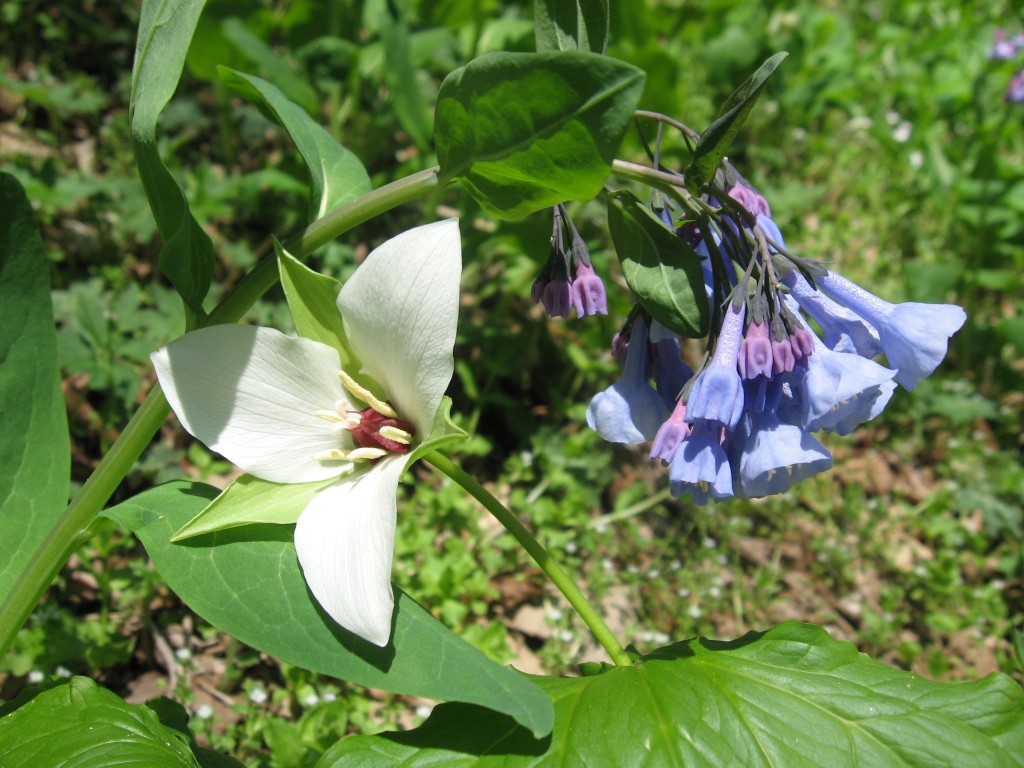
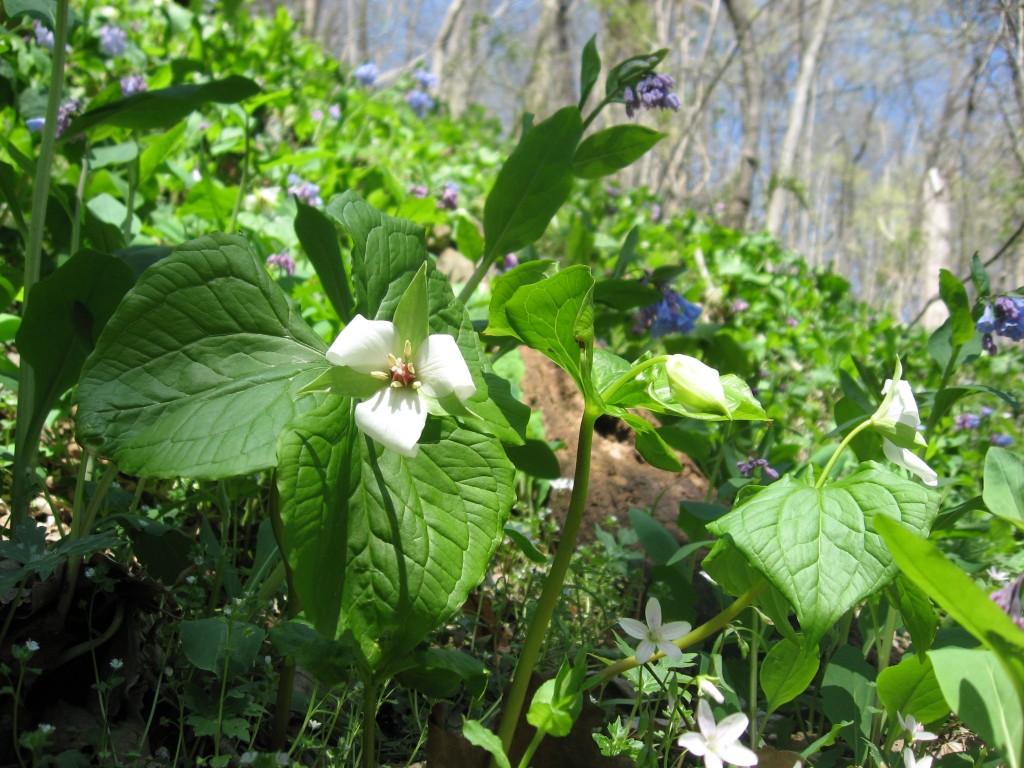
This is the quintessential Shenks Ferry Wildflower Preserve scene in the springtime.  A steep hillside covered with Bluebells, Trillium, and Claytonia virginica, spring beauty. This is what we came here to see.
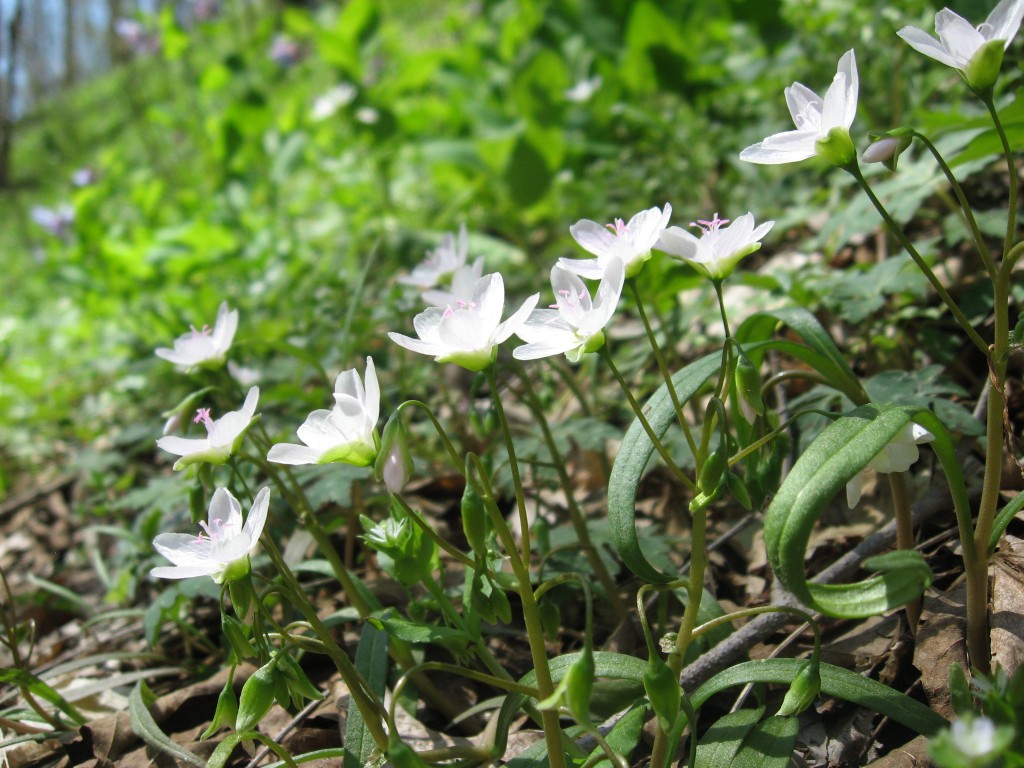
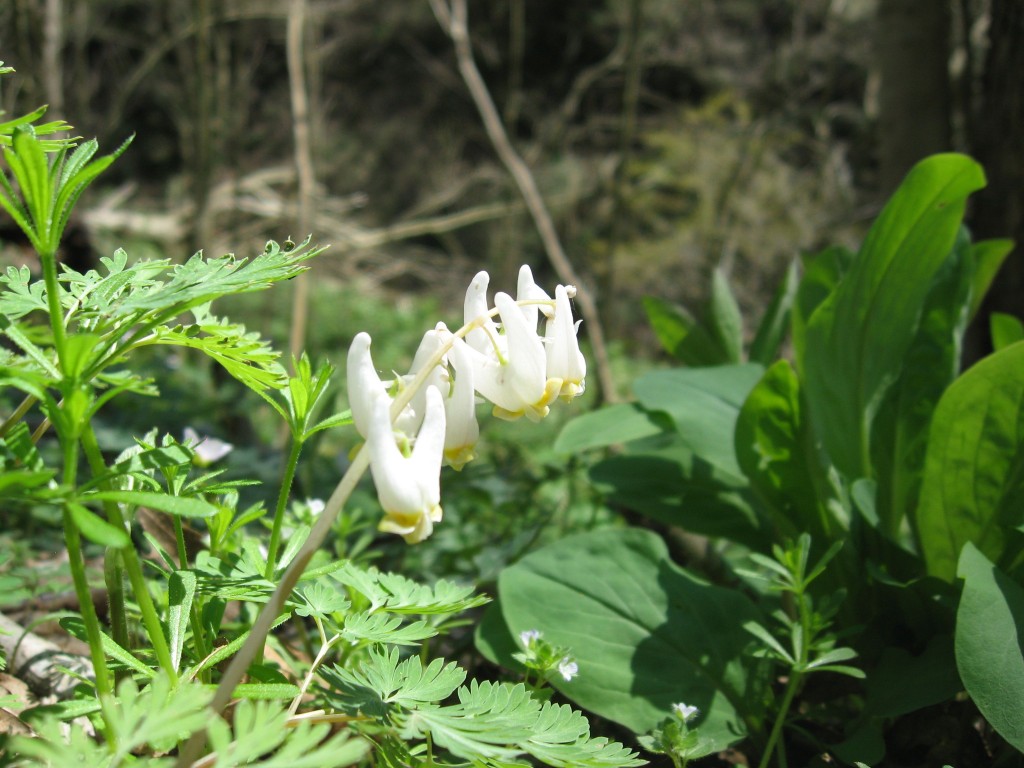
DICENTRA CUCULLARIA
The Dutchmans breeches is a flower we have been trying to grow in the front yard, and have not yet had a flower.  Every year they grow little green branches about 4 inches high with heavily dissected leaves and seem happy enough, only to eventually go dormant.  No flower though.  In Shenks Ferry, flowering Dutchmans breeches are covering the hillsides. They grow out of a corm, similar to that of Trout lily , and  the invasive exotic, Ranunculus ficaria, the Lesser celandine.  The corms of Dutchmans breeches form dense networks, and  likely play a part in the soil retention of the steep slopes of the ravine habitat.

This is the woodland foot-path of Shenks Ferry Wildflower Preserve. It is situated about 25 feet above Grubb Run, the creek that runs into the Susquehanna. Â At this elevation, We were afforded a great view of the creek and we were well-placed to see the wildflowers on the hillside. This is what one of the rich ravines of the lower Susquehanna River looks like.

Isabelle basks in the sun alongside the Bluebells and Trilliums.
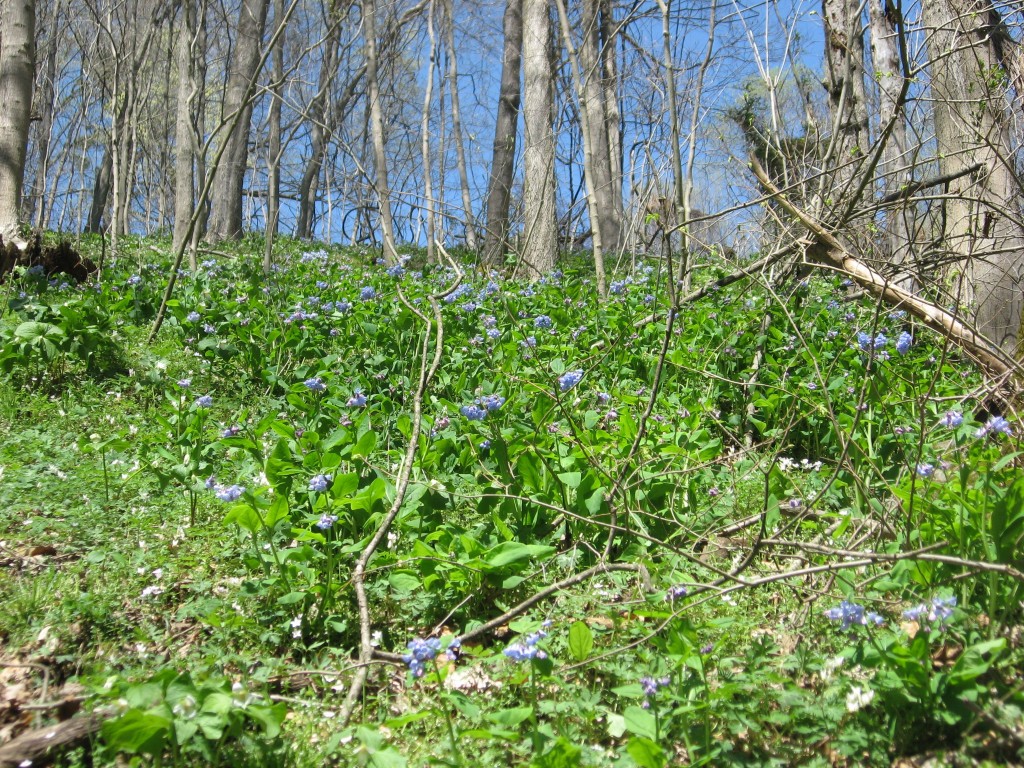
Looking up the slope of the ravine to the bluebells above.
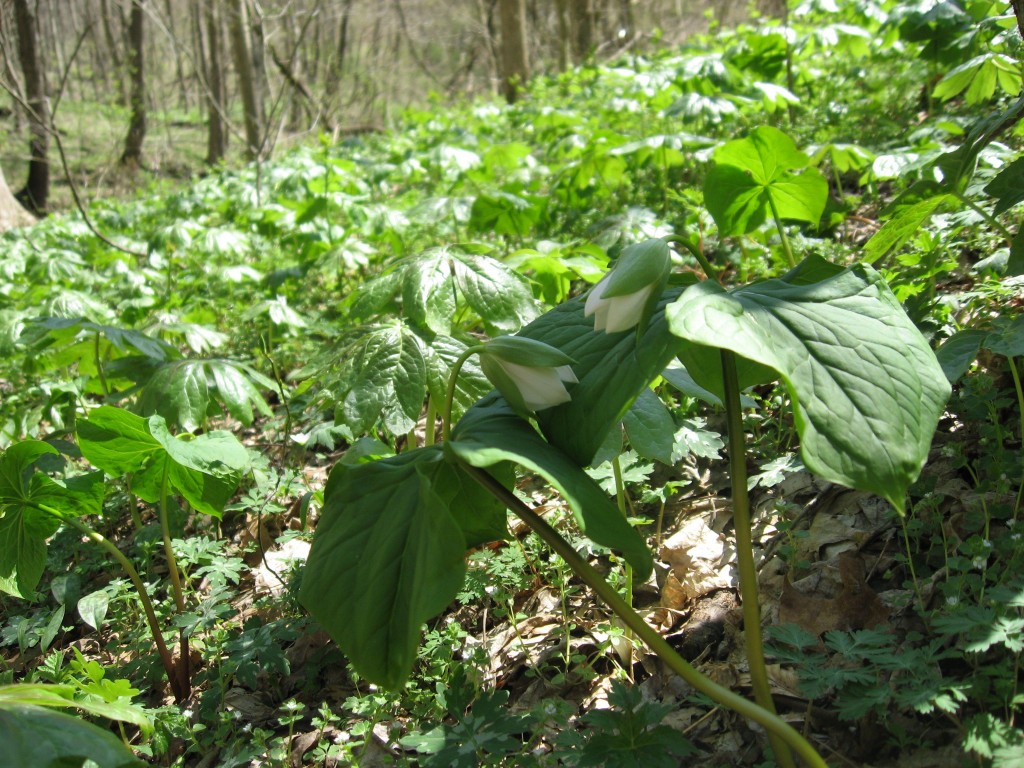
Trilliums and Mayapples
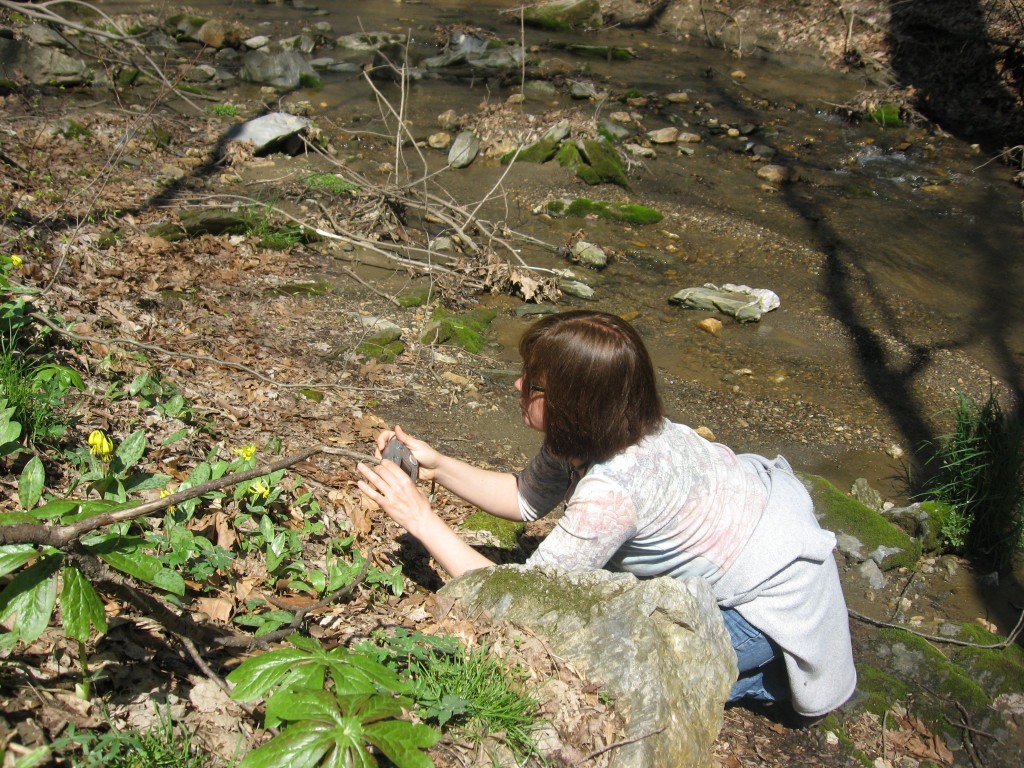
Isabelle photographing a Trout lily along the banks of Grubb Run.
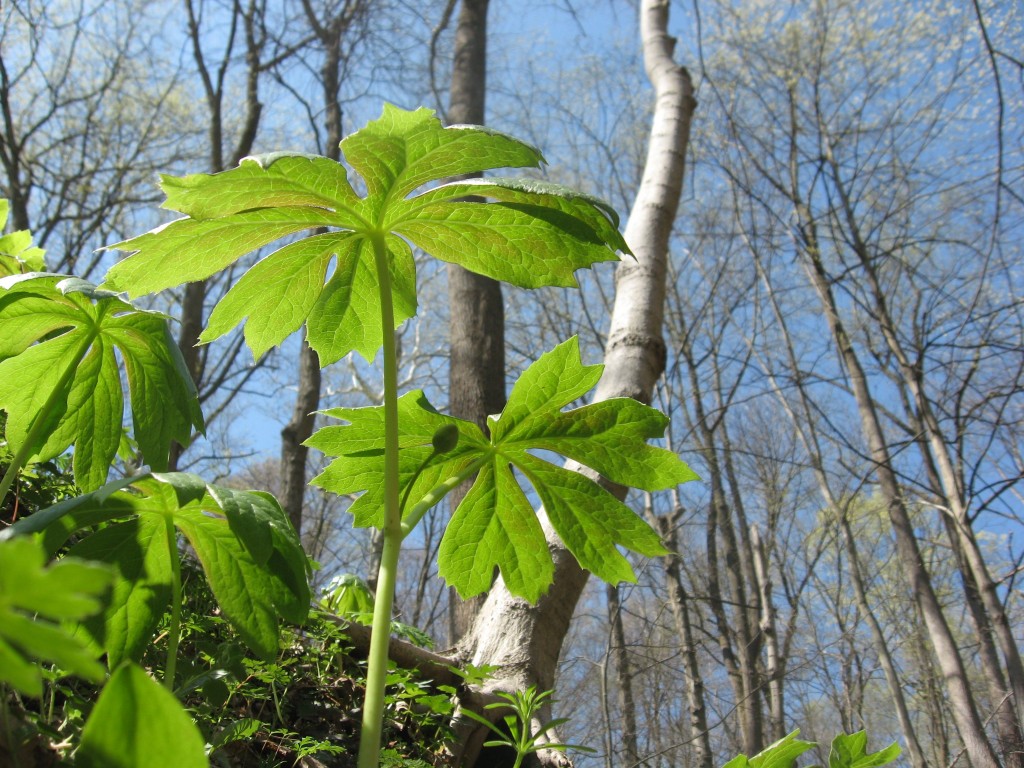
Mayapple, (Podophyllum peltatum)
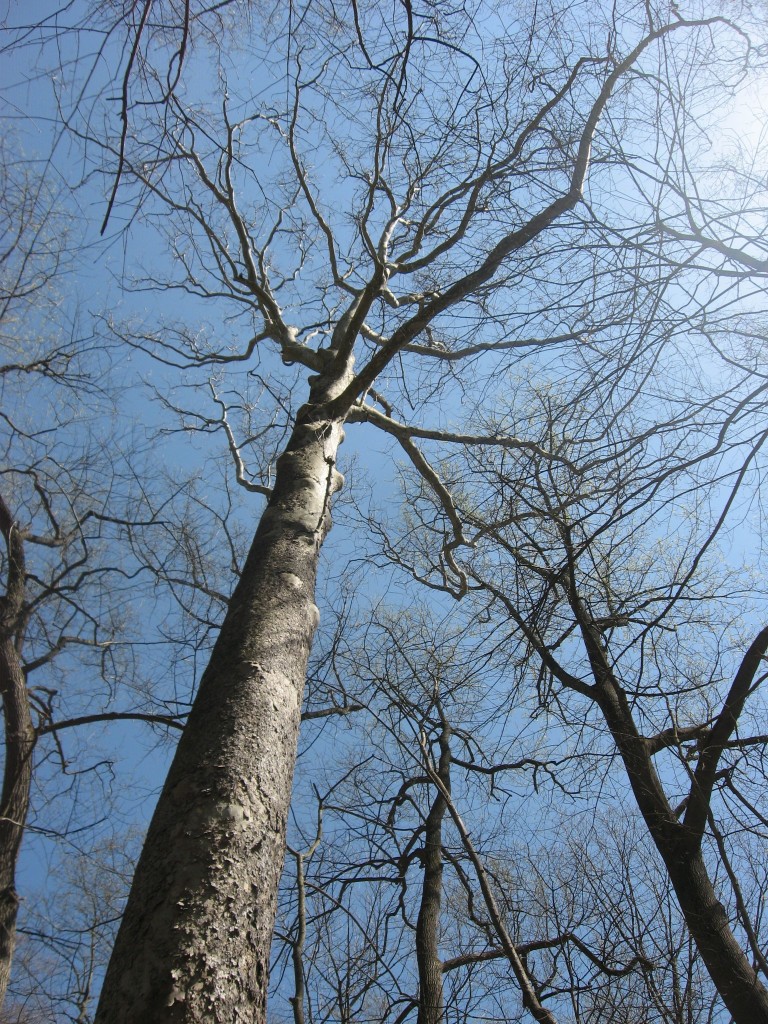
A giant Sycamore (Platanus occidentalis) grows right on the creek bank.

Erythronium americanum, the Trout lily, growing alongside the creek.
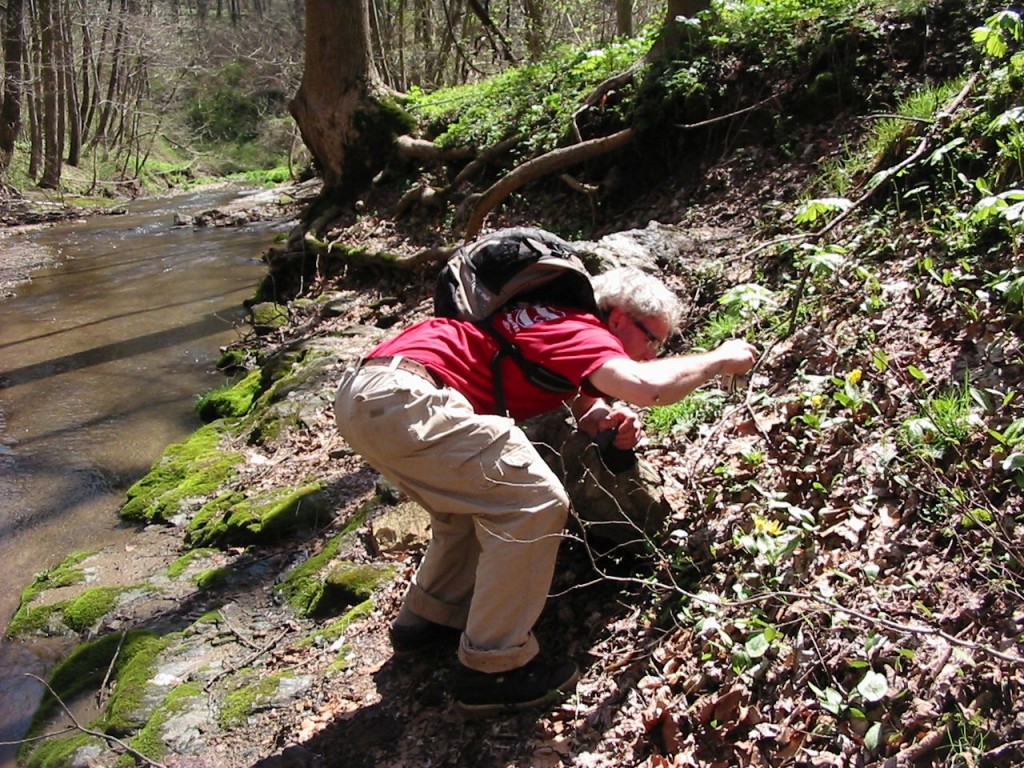
This is what it takes to get that picture. Great measures are taken to not step on any plants or disturb any ecosystems. We stay on paths. This one path led down to the creek so we went for it. There were plenty of rocks to step on.
The new format of digital photography allows for many pictures to be taken at different angles, to get that shot. If the picture is blurry or at the wrong angle, a simple delete click will eliminate it.

It was so exciting for us to see so many flowers at once in such a short time. After a few hours, we stopped snapping pictures and just looked at the flowers, and settled in.
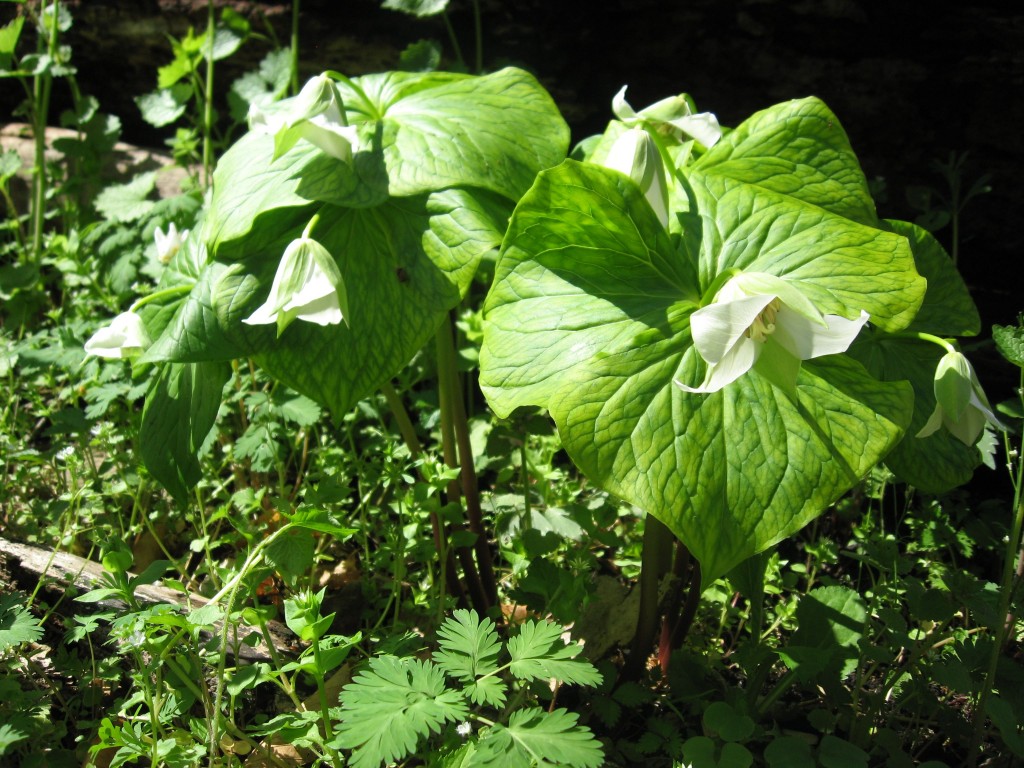
However, that did not last long, as we came across this patch of Trillium flexipes, and Dicentra cucullaria, there was no way we could not take some shots and bring the image home.
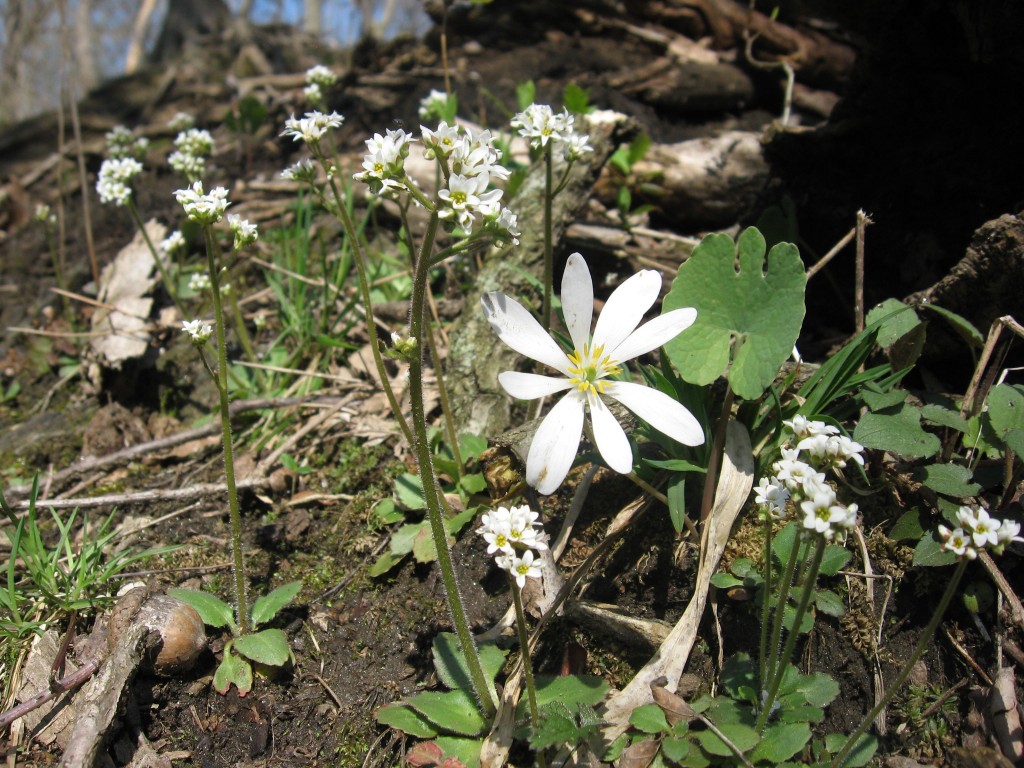
We found a path that led us up a steep hill into a more upland environment. Â Here we found Bloodroot blooming next to Early saxifrage (Saxifraga virginiensis). Â It is interesting how just a few feet in elevation completely changes the environment. We had not been acquainted with Saxifraga virginiensis before, but we are charmed by its elegant white flowers and modest 4 inch stem, and especially the small rosette at the ground level. Â It is such a natural neighbor to the Bloodroot in this ravine.

We made our way back down to the creek to find this snake also completely enjoying this  mid -April Thursday afternoon in Shenks Ferry.


A hillside of Trilliums and Bluebells in the springtime. Â The Happy Place: Shenks ferry Wildflower Preserve.
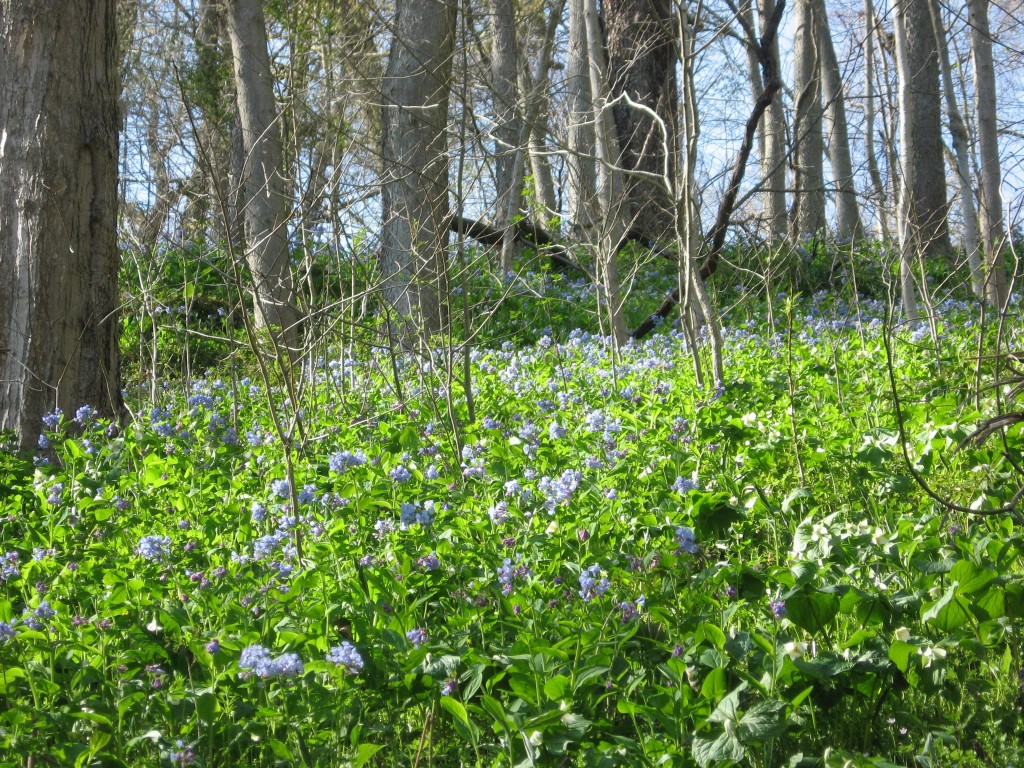
Bluebells as far as the eye can see.
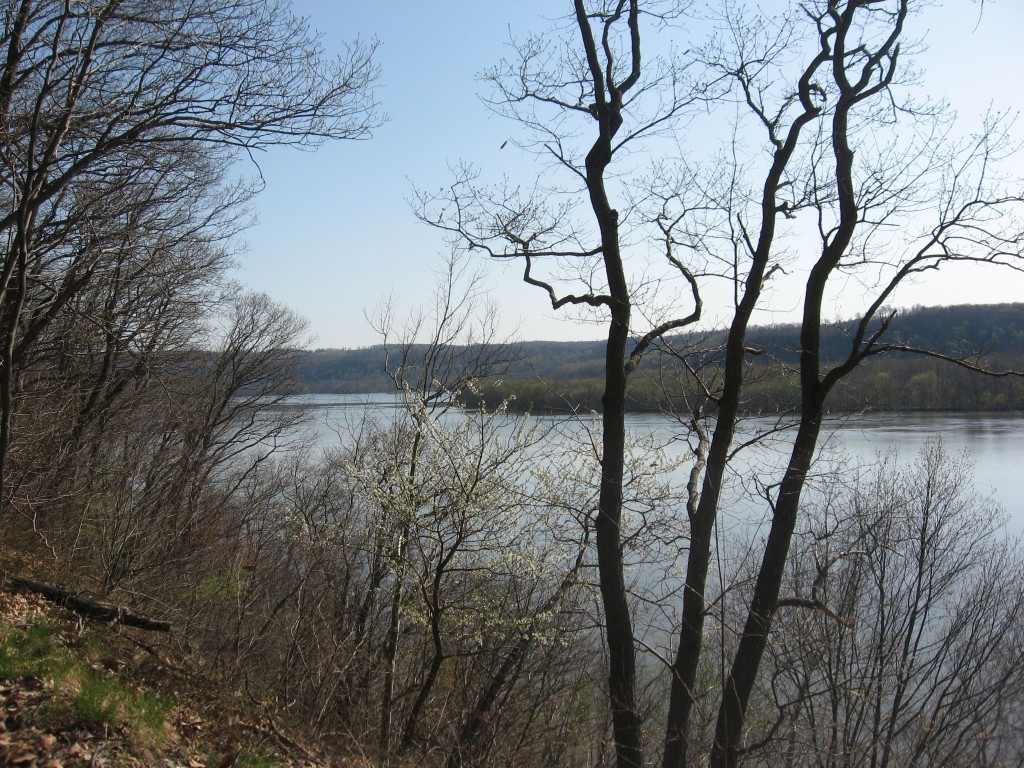
This is the view just a 5 minute walk up a steep path next to the trail head.
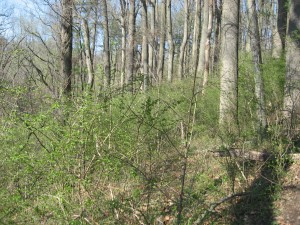
On this small path we encountered a disturbing scene. Â An infestation of Euonymous alatus, the exotic invasive burning bush, overtaking the Trilliums along the path.
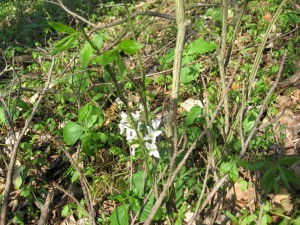
The Trilliums can barely flower amidst this infestation.  The invasive seedlings of Burning bush were crowding out the native wildflowers.  The close proximity of this dangerous invasive to the all of the habitat we documented in this entire post was a sobering scene. This infestation reminded us that we cannot escape the invasives, and that the problems we face in Morris Park  are everywhere. In a way, we can clearly see that Shenks Ferry Wildflower Preserve is not a fantasy escape of happy wildflowers growing in a rich ravine, but a place just like many others: A happy place of diverse species and some invasives, at risk of becoming degraded.
Even the ride out of Philadelphia was a constant reminder of the increased development and urbanization that is creating habitat loss and depletion of natural areas.

Hopefully we as a species will learn to appreciate and protect the natural habitats that are responsible for our own survival. The big box store, the housing development and the landscaping, as well as the  introduced landscape plants that become invasives destroying the forest remnant behind this creation, will not sustain us in the long term.
The Forest remnants that are still intact can provide us with some glimpse of how we  may want to arrange our own built ecosytems, just as they may provide a hint to how we may want to arrange our native plant gardens. The forest remnants and the remaining plants most likely will have the most to teach us about what it takes to have  a sustainable ecosystem.  Just to note, these ecosystems have  been around for thousands of years.  We did see lots of mini-malls and parking lots and invasives, but we also made it out to Shenks Ferry Wildflower Preserve, and we saw the beauty of our area of Pennsylvania. It was a great joy to see the plants and the environment of this rich ravine.
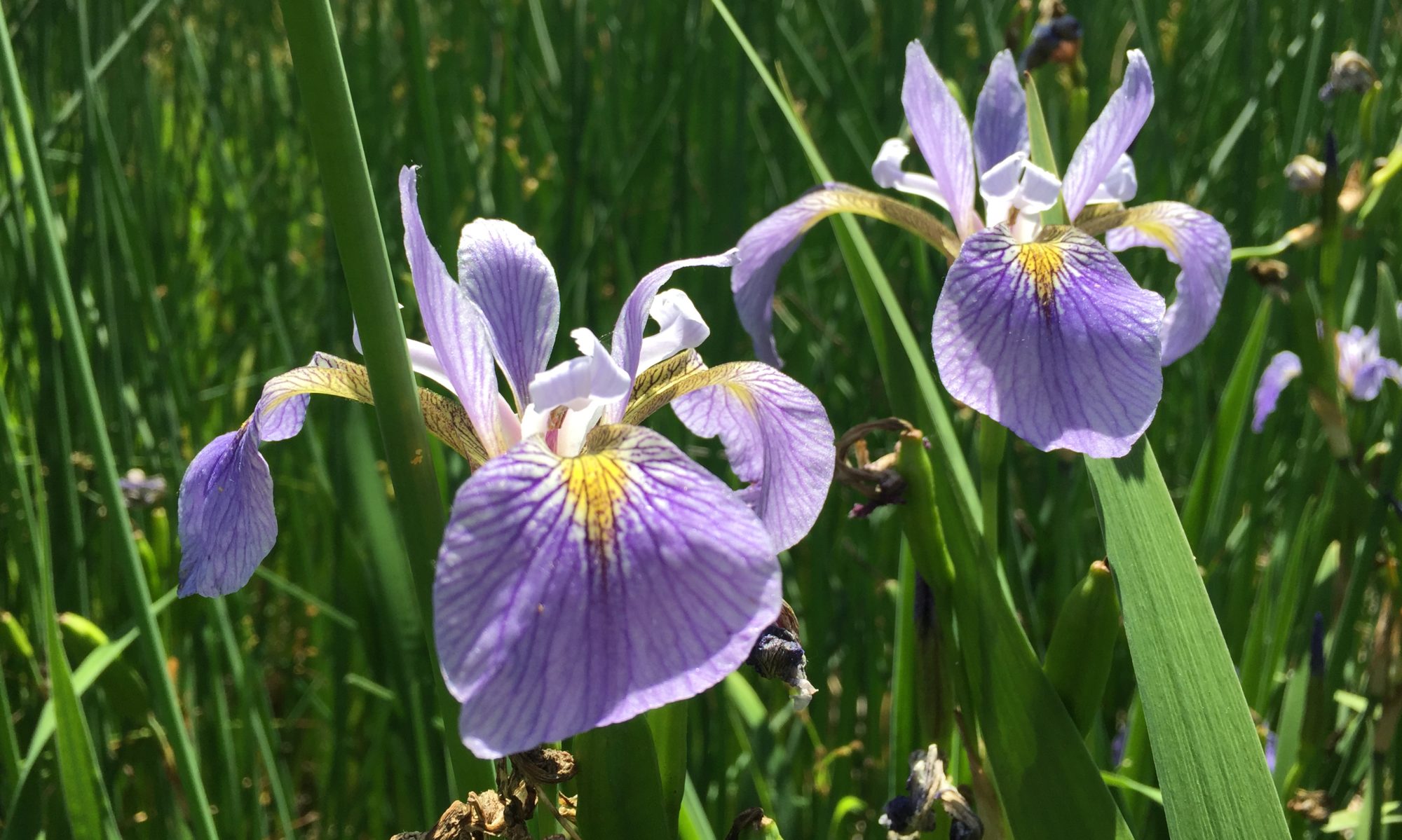
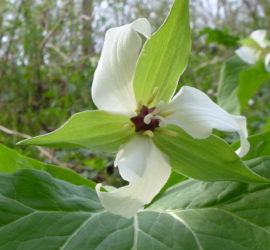

The tunnel provides passage for Greenwood Road through the huge fill that carries the Atglen and Susquehanna (A Pennsylvania RR subsidiary). The RR was constructed in 1903 and abandoned in 1967.
Stone abutments along the wildflower trail show that it was once a car line, but I have not been able to find out anything about it.
Hi, i waswondering if I can include your web site as a resource for an upcoming column about wildflowers. You can email me at rkobell@bayjournal.com. Thank you so much, Rona Kobell
I’ve been there numerous times in very ordinary, urban, 2-wheel drive vehicles with modest clearance. Yes, it’s a dirt road in and out – you can approach from the tunnel end and go down past the entry and depart by driving up the other side.
But you should, as always, drive carefully. Especially after heavy rain which may have caused damage tot he road.
The dirt road really adds to the adventure of going to Shenks ferry. When too many people show up at once, the trilliums get trampled on, an unfortunate sight we have witnessed.
How disappointing. We tried to go (Honda Civic hybrid, husband, wife, six-year-old and infant. I had meticulous directions. I got halfway down the dirt road and feared I wouldn’t make it. I had to back up. We tried again around the other side and it was still dicey looking. They should let people know that it is a windy dirt road and not suitable for all vehicles.
Rona, so sorry to hear about your difficulties trying to reach shenks ferry. we dented our oil pan one trip there in our four wheel drive subaru! Yesterday we parked right outside the tunnel and walked the rest of the way. The road before the tunnel is the most intimidating. You must have been so frustrated.
Great pictures! I’m learning a lot about plants from your website.
Thank-you Mike. We learn more everytime we get a chance and love to pass on our observations and insight about plants
Three cheers for PPL for this terrific sanctuary! Your description sounds so much larger than a 50-acre preserve. It must be beautiful.
Is the tunnel an old railroad tunnel & the path a RR r/w? It sounds so inviting I’m thinking of dragging my view camera with closeup lenses next time we visit.
Richard
We are not sure but there was a dynamite mine in Shenks Ferry, and it is possible that the tunnel is an old railroad tunnel. There is a right-of-way above the tunnel that we know is an old railroad right of way. There is also an active railroad line right at the trail head. This is where the flower people meet the train people. There is a lot of industrial history in this area. Bring your view camera for the best flower pictures!